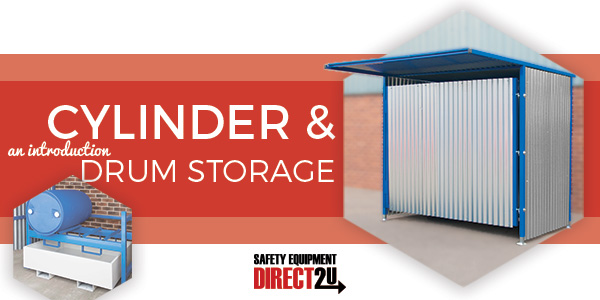
At Safety Direct2U we know that compliance with Health & Safety regulations is of greatest concern to all employers. More often than not. When we begin our research into Health and Safety requirements it becomes somewhat of a minefield. As well as incredibly daunting. That’s why we have put together this concise list of key considerations. To give introductory help and support towards your Cylinder and Drum Storage policy.
Storing Drums and Cylinders. Where do we start?
First and foremost, it is important to properly understand the substance that you are storing. In addition to any potential hazards it could present. For example, in some cases you can store a perfectly safe liquid – like water – in high volumes within HDPE drums or IBC tanks. Although on the other hand. Some companies need to store large quantities of corrosive or flammable substances to assist with their day to day business function. In this instance, you will need to refer to HSE guidelines on the maximum quantities that can be held within a single storage unit or area. This information can be found within HS(G)51 Storage of Flammable Liquids in Containers or HS(G)40 Safe Handling of Chlorine from Drums & Cylinders.
Drum Storage. What is the best location?
At this point you should be aware of which classification your stored substance sits within. Initially, it is important to keep our stock within workable boundaries for the business. However, as HS(G)51 and HS(G)40 highlights, we need to think about the volume of substance we intend to stock and the hazards of this material. This in turn will enable us to determine any required segregation. Separation should be based on potential harm on personnel, the public, surrounding buildings and the environment. The HSE have an advisory article which may help you with this.
Do we need a Drum Storage Unit with Ventilation?
Once you know the best place for your drum storage. You need to ensure that any flammable liquids and gases will have access to open air. This will consequently allow any vapors to disperse. If the most suitable location is within a building or container unit. It must have explosion relief, be fire resistant and have good ventilation. You can achieve good ventilation via permanent openings or louvre vents.
How should we store our drums or cylinders?
Safe drum and cylinders storage depends greatly on weight. With this said, if you want to stack your drum or cylinder containers, you need to ensure the construction of the container will withstand any exerted loads. You can use Drum Racking or Freestanding Stacks if necessary. However, you must take the necessary precautions to accommodate for any leaks or spills. A large number of purpose built drum or Site Storage Containers are bunded and leak proof. If your store is not bunded, you can buy Spill Pallets and Drip Trays to help with with this.
What measures can we take to reduce damages in the event of an emergency?
The most effective way to reduce the impact of an accident is to give thorough training to those who will have access to and be using the stored substances. You should conduct training and refresher sessions on a regular basis, while keeping accurate records of participants.
Additional emergency actions should also include Substance Extraction methods, Spill Containment procedures and Manual Handling processes.
If you need any further help or support with your site, drum or cylinder storage needs then Safety Direct2U are here to help. Simply get in touch with our friendly Sales Team via live chat. We will do our best to answer any question you may have, or to arrange a no obligation site visit if required.